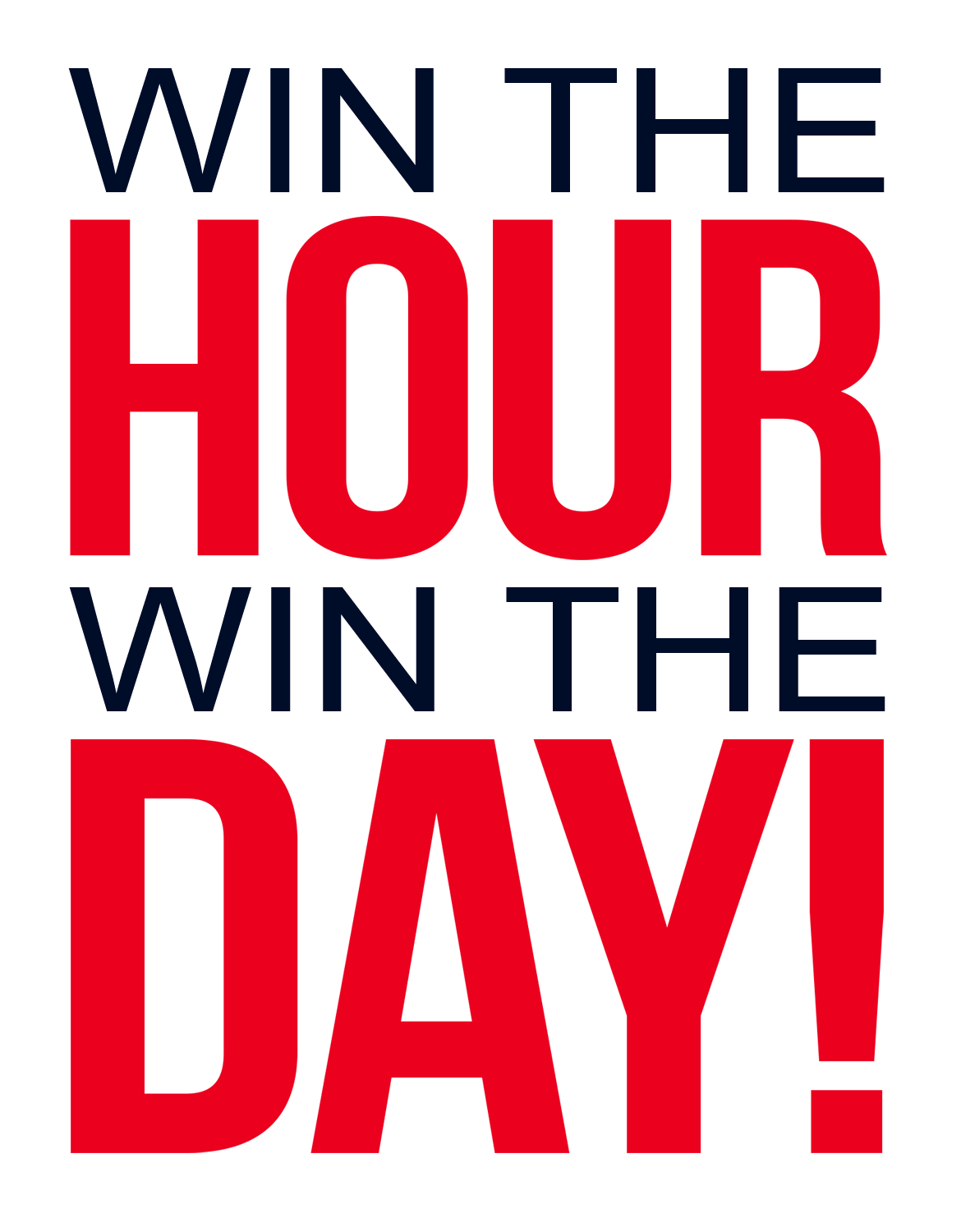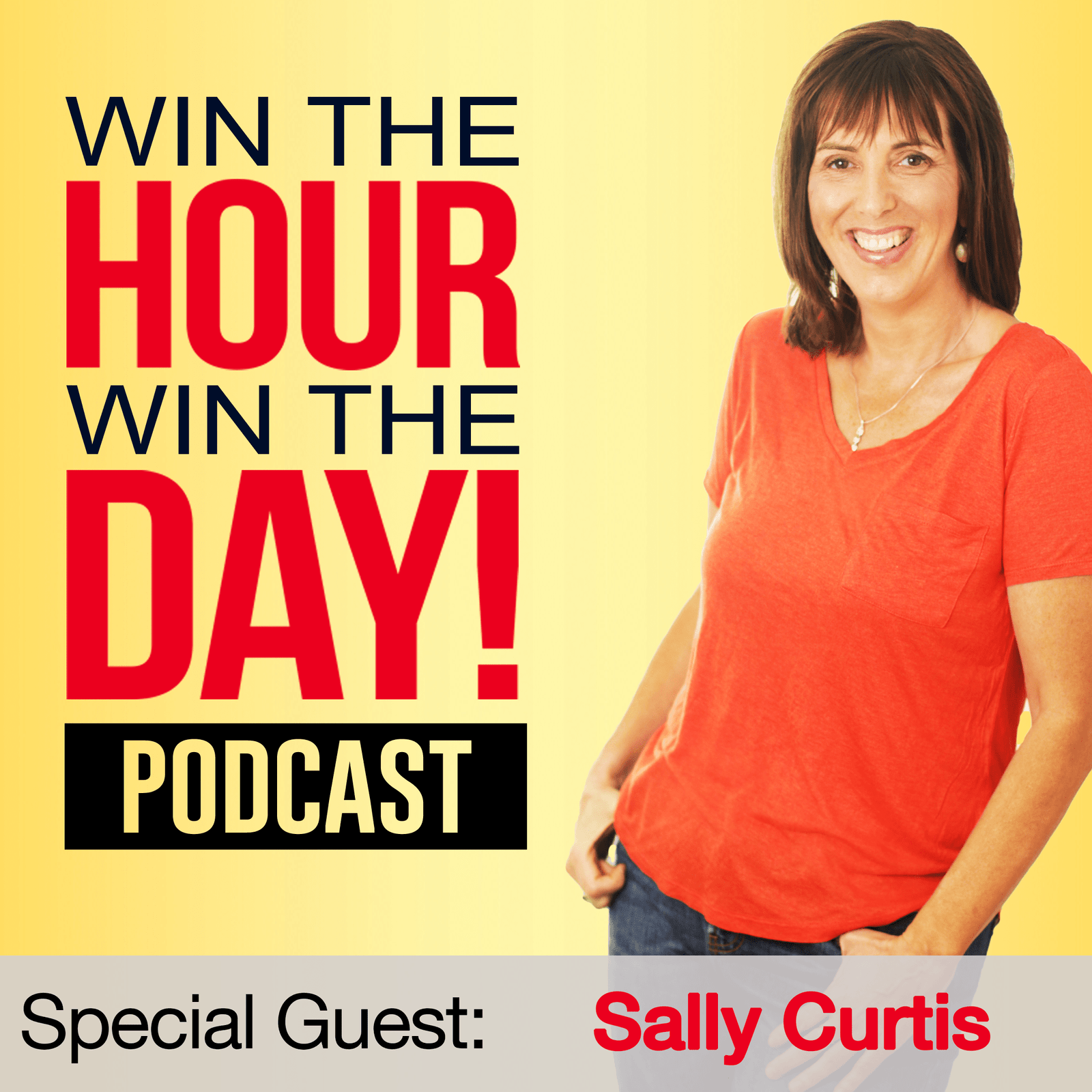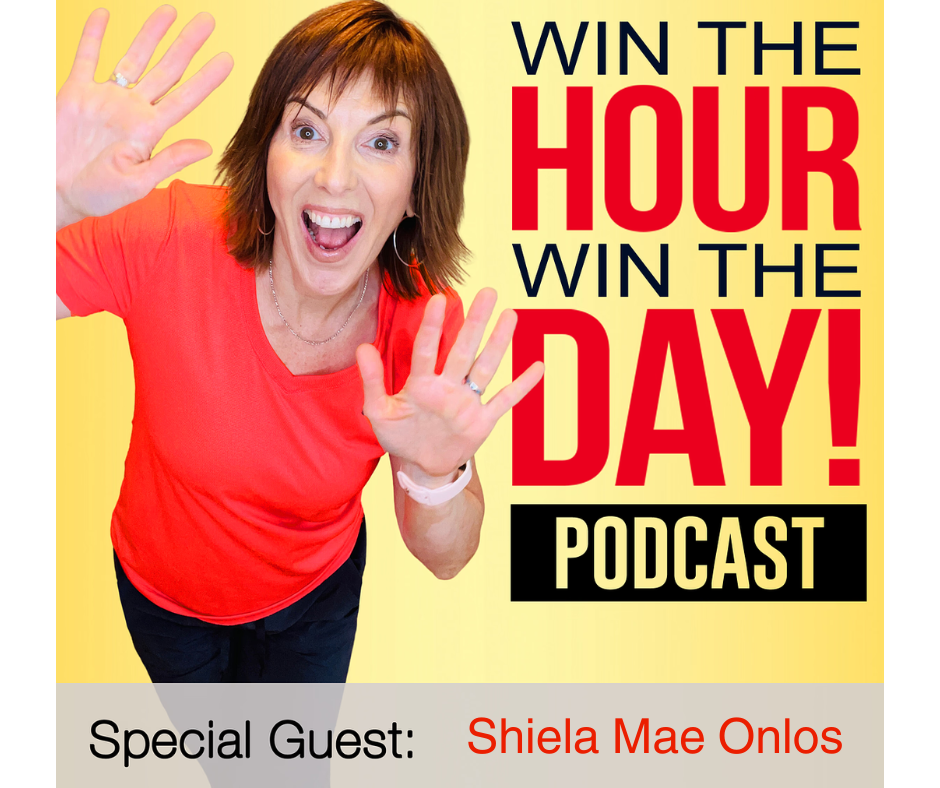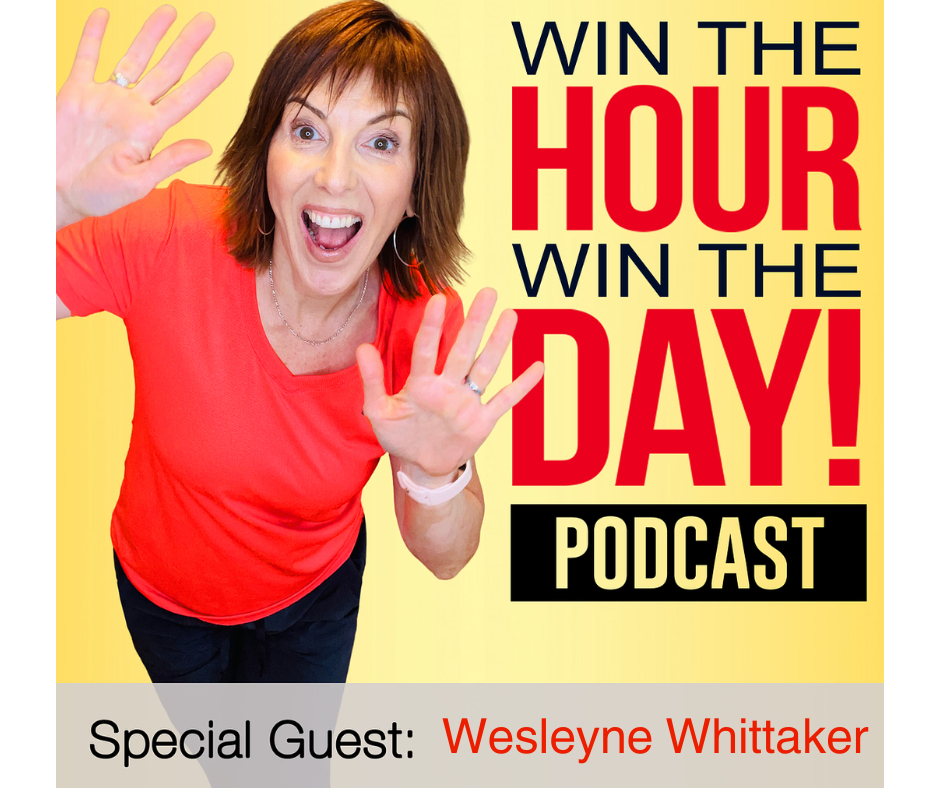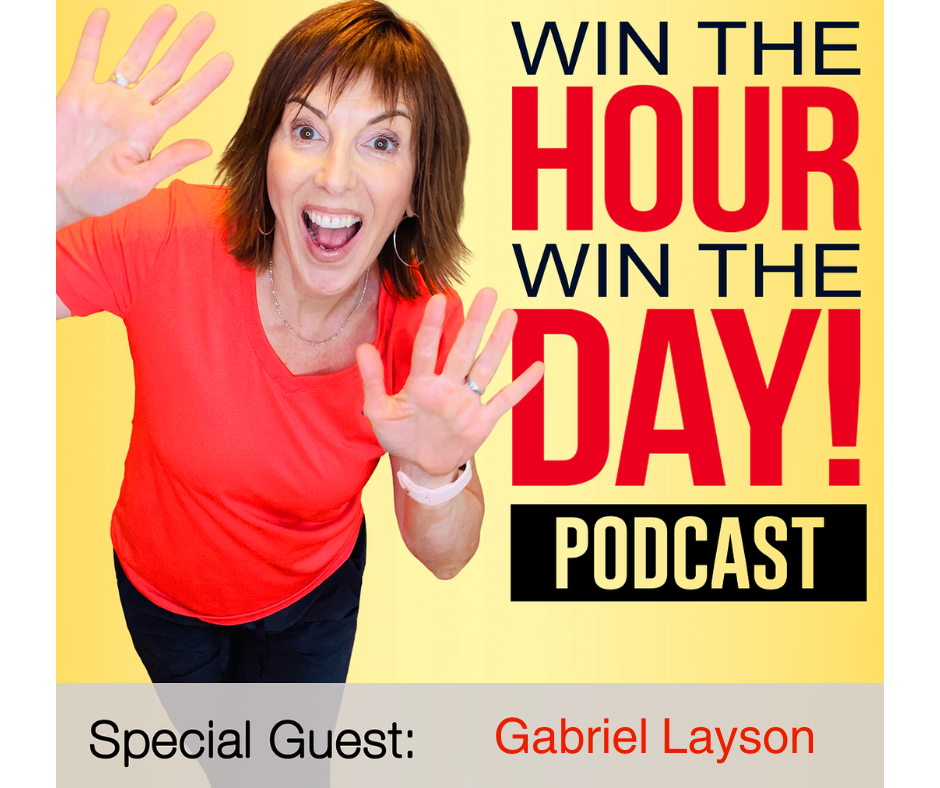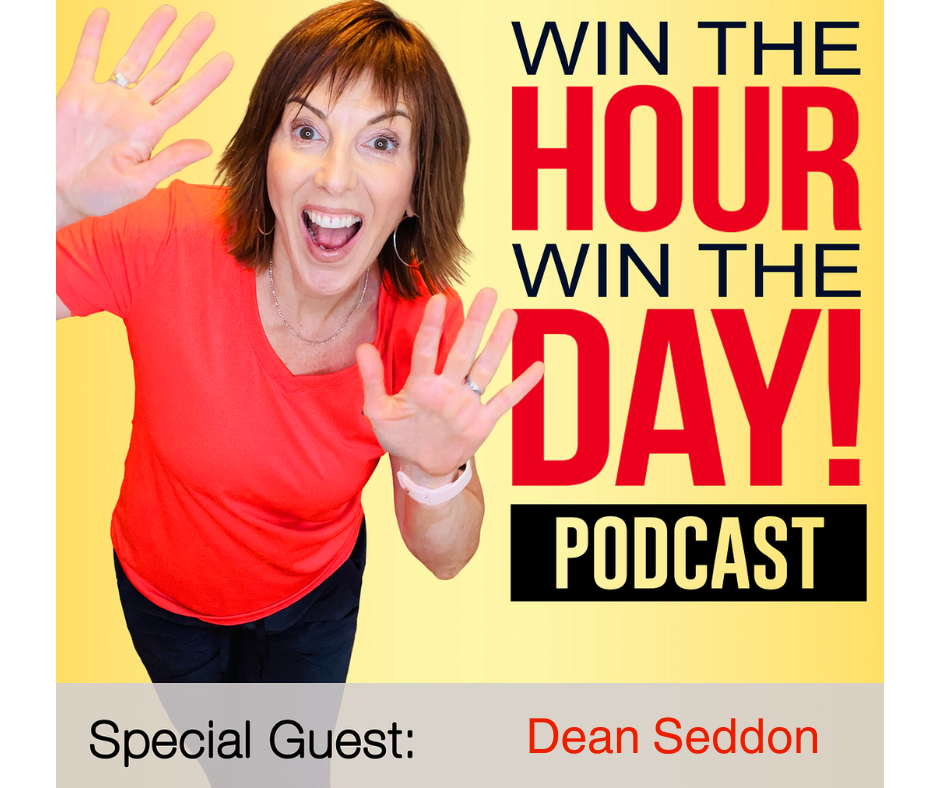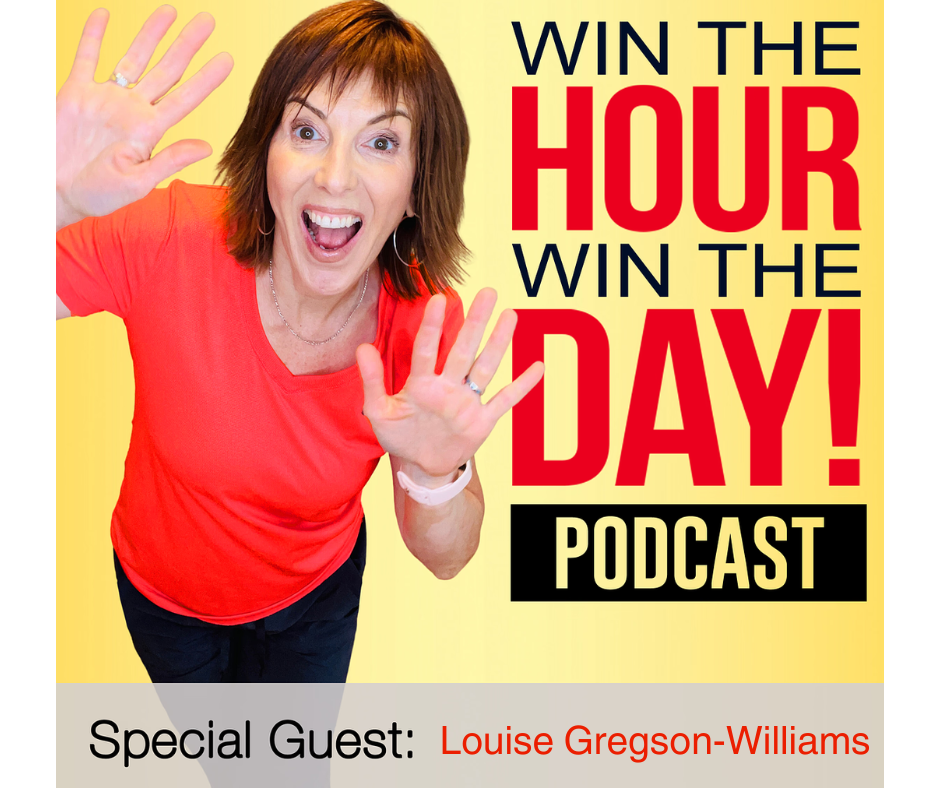Episode Summary
Sally Curtis gives us the goods on how to easily and effectively repurpose our content. Listen in and hear all my “aha” moments.
Learn
-why you’re leaving the best part of your content behind
-secret hacks to repurposing any content!
– how to make your content MORE interesting regardless of your work or industry!
And much more!
You can find Sally Curtis at:
Website: https://www.sallyacurtis.biz/
Email: sally@sallyacurtis.biz
LinkedIn: https://www.linkedin.com/in/sallyacurtis/
Facebook: https://www.facebook.com/imsallycurtis
Win The Hour Win The Day
https://winthehourwintheday.com
Sally Curtis Podcast Transcription
[00:06:00]Kris Ward: Hey, everyone. Welcome to another episode of Win The Hour, Win The Day and today in the house we have Sally A. Curtis. Sally A. Curtis is going to talk to us about repurposing our content because she is the content repurpose whiz whiz. That’s a good one. Welcome to the show, Sally.
[00:06:22]Sally Curtis: Thank you so much, Kris. It’s an absolute pleasure to be here today. Thank you.
[00:06:26]Kris Ward: Oh, excellent. All right. We’re all about big results. No fluff here. So we’re just going to dive in and I even said to you, okay, Sally, we’re going to talk about repurposing content. So listen, you guys, I got you.
[00:06:37] I hear you friends out there. I know what we’re talking about. Oh, no. I didn’t have to take this blog and have to repurpose it and takes hours. So I sent that to Sally. What’s going to be different than other aspects? And so Sally had some interesting ideas. So let’s dive in, Sally. What do, where do we start when repurposing content?
[00:06:55]Sally Curtis: I think the easiest place to start when you’re repurposing content is actually not to over complicate it. And everybody writes articles of some form. Even if they’re 400 words, 500 words, 700 words, they write articles. And the thing is, is to actually scan it, not get bogged down and rereading it and making it hard work, but scanning it intuitively and wait to see what actually jumps off the page.
[00:07:22] What pops. And with that popping is usually a throwaway line and throwaway lines are usually at the bottom of a paragraph hidden because you know, they’re not important to us, but they often are highly important to the audience. So I think it’s. Content repurposing done in its simplest forms is pulling out those little throwaway lines, those little tips, those little ass statements or quotes or rants that you have when you’re talking or sharing with your audience and actually turning them into a graphic visual tile.
[00:07:58] So the easiest way to explain to the audience what that is, is think of a postcard, a postcard and visual graphic tiles. It’s small. It’s bite-size and it’s easy to read and understand because it’s visually appealing, but it’s just got a very good, a typical message on there that the audience resonates with.
[00:08:17]Kris Ward: Okay. Let me jump in here. So I’m thinking, right like a quote card, but it could even just be a tip. It doesn’t have to be like one simple quote. It could be a smaller font. So it could be like, you’re saying a bigger thing, like a tip, not just a quote card. So it’s a tile. Is that a different fancy word for like a graphic quote card type thing?
[00:08:37]Sally Curtis: It is referred to words at a tile because a tile has, when somebody thinks there’s a graphic quote tile.
They just shut themselves down to it. Just being a quote. Tile gives you flexibility. It can be a tip. It can be a do’s and don’ts, it can be a, “Hey, here’s a great saying.” Or it can be a question or it can be just a visual that creates a sense. So the tile in the sense of a tile has flexibility. Like a postcard has flexibility.
Unlike the better quote tile, it narrows people’s thinking down and don’t create possibility thinking.
[00:09:18]Kris Ward: I got it. All right. So, okay. Which reminds me too of. So, you know, we’re all about what we call… Like, we believe that most entrepreneurs are just trapped in the web of admin. So we always want to be in what we call the execution mode.
[00:09:32] The WIN Formula is 60% execution mode. And some of the things I found over the years too, is whether I’m on somebody else’s podcast or anything where I’m talking all of a sudden, sometimes I’ll hear myself say something like, oh, oh, I should write that down. That was kind of somebody prompted a different answer out of me.
[00:09:49] And what I’ve learned from that too, is… I will then record if I’m somebody else on someone else’s show, I then also record my screen and then my team will go through it and they will highlight things I said so that when they present it to me, I don’t have to reread the whole thing. And even if they just take out the jibber-jabber or this, that, or, you know, and then focus on the key points I read and see those differently than I. I’m like, oh, this is because, let me tell you three stories at the same time, Sally pay attention.
[00:10:22] It’s kinda like when I had to read my book, the Win The Hour, Win The Day book, I then had to do an audio version. So you have to sit in a room and read your own book and heaven helped me. And I mean this with, you know, humble bragging, there were points in there that I went to stop to write down. Like that’s a good point.
[00:10:39] Kris you wrote that book this year, these are your points. But when you’re reading them, when you’re coming at you from a different perspective, whether it was because it’s a delayed thing, I read it months later or reading it is different than writing it. I don’t know. But here I was starting to make notes as if I was reading it and I bought it off Amazon.
[00:10:56] I’m like, come on, man. Like this, these are your words. So I think the repurposing, sometimes doesn’t only allow you to get a lot more mileage out of it, but I think you see it differently.
[00:11:08]Sally Curtis: And what you’ve just described there so beautifully is what I would call the Inspired State when you’re actually looking at a book and you’re not looking at it as hard work or your article or whatever you’ve done before.
[00:11:22] To see it through different lenses. And you’re seeing, oh my God, that’s a great statement. That’s like, oh, that’s a great tip. You’re actually in that inspired state, which is more intuitive or instinctive and that’s the state you want to be in because that makes it easy. And in flow versus when you think sit down, write, I’m going to write, write.
[00:11:42] I’m going to do a content repurposing,you get into a methodical mode. Which is often harder work to get into with. So that’s sort of the why of ad when you repurpose content, well, it’s done in that sort of playful state because you’re looking through different eyes. You’re sort of hunting as well as like a tricky, right?
[00:12:06]Kris Ward: Okay. That makes a lot of sense. You are absolutely coming at from a different spot. The hunter versus the creator. Which is how you read other people’s books. Like you’re like, oh yeah, this is okay. This is interesting. Highlight, highlight, highlight. Okay. Excellent. All right. So let me, get out of your way and tell some other things that we’re missing. That we’re overlooking as far as what we could be repurposing.
[00:12:31]Sally Curtis: Very much. So from a tips perspective, let’s definitely go back to the throwaway lines. Just to clarify what I mean by that. Cause it’s very easy to say a throwaway line, cause I know what that means. A throwaway line is usually the very last thing somebody sums a paragraph up with and it’s usually the third paragraph.
[00:12:53] That statement, that’s a summary, is a great statement to pull from an article or a blog, because it is actually a summarizing statement from the topic that you’re writing from. So you’ve got your topic, which could be the title of your tile. And then you’ve got these little throwaway lines. There’s often three of them, which you can then pop as your tips on tile with the visual image. Sorry, Kris, go ahead.
[00:13:20]Kris Ward: No, no, that’s okay. I’ll interrupt you a lot. So I think too, for me, anyhow, that tile keeps… you’re right I keep getting stuck on one little square thing, like a quote and not realizing if it’s a graphic and it’s three sentences, we just make it a bigger tile. We just, so that’s fine.
[00:13:37] I think we are so narrow in our thinking. So when you say that, I’m like, well, how do you fail that in a little card? We’ll make the damn gosh. Oops. Hello. People make the graphic, make the graphic bigger. So a tile, like, I guess a tile in your house can be different sizes.
[00:13:52]Sally Curtis: Correct? Yep.
[00:13:54]Kris Ward: I’m a slow learner, but I’m catching on. Got it. All right.
[00:13:58]Sally Curtis: And from a re-purposing perspective, I’ll just add this little nugget, cause you’ve just reminded me and then obviously different social media platforms have different sizes. The one that we use most, mostly isn’t Instagram style S-size tile, because that can be used on all social media platforms.
[00:14:19]Kris Ward: Okay. Write that down, everybody. So use Instagram as your framework. And then you can repurpose that anywhere.
[00:14:27]Sally Curtis: You can resolve obviously in Canva as well. But you know, if you just want to make it quick, fast, and create a library of reusable assets right now, Instagram’s your way to go and then you can resize them.
[00:14:40]Kris Ward: Oh, so you’re going right into Instagram to make this tile?
[00:14:43]Sally Curtis: No, no, no, in Canva
[00:14:45]Kris Ward: In Canva with Instagram size. Gotcha. Okay. I’m with you. I’m with you, I’m keeping up.
[00:14:50]Sally Curtis: Good. Good. Good. Now just going to share another tip as it relates to the graphic tiles, cause we’ve talked around images and I wanted to share the tip on the image positions, the viewer.
[00:15:03] So you’re going to have to listen in and lean into this one. Okay. So if you think of a graphic tile and we’ll go back to the postcard analogy that a picture paints a thousand words we use. Well, we’ve all heard that before. Let me tell me, tell you a quick story about a client. Now I’ve got a client who is in the peak performance space, so high-end peak performance.
[00:15:25] Her overall statement or compelling statement is assess don’t guess. Now her clientele are aged care facilities, senior executives and world athletes, world champion athletes. So very diverse. Now what I want you to do when I say those words and I’ll repeat them again in a minute, have a think about the difference in the images that come up.
[00:15:56] I said, aged care facility, senior executives and world champion athletes. So when I say the image positions, the fewest, of course, we all have our own perspectives on life and our own life learnings and our brain sorts based on our own perspective. So when she creates her tiles with her simple message, assess don’t guess, she uses the visual images to position the viewer.
So if it’s an aged care facility, for example, and I say images that are aged care related, I will stop and pause at the tile is all about stopping the scroll and creating engagement, but they won’t see the senior executives and they won’t see the world athletes because it doesn’t relate to them.
[00:16:47]Kris Ward: But isn’t that kind of odd, like that’s a real wide swing that most of us wouldn’t have. Cause most of us would get stronger and stronger as we niched down. So I traditionally don’t work with entrepreneurs that are new in business for a couple reasons. So I’m usually dealing with people that have been in business like five years, service-based entrepreneurs and they are working still harder than they expected to be doing this at your 6, 7, 8. Right. So, I guess there wouldn’t be a big variation in the images I’m using?
[00:17:21]Sally Curtis: Ah, so let’s go into the… what we use the word transformation. So at tiles, for example, your audience seeking in your case would be seeking a transformation. So they’re stressed out. They’re looking tired and fatigued and will those sorts of things.
[00:17:40] And they’re wanting to feel empowered and those are empowered on top of things in control. So even those two images in themselves, depending on the wording on the tile, it could be, are you feeling stressed, et cetera. So you’ve got your fatigue looking person looking for this. This is your transformation person.
[00:18:00] So that’s where the choreography of good storytelling through images. Becomes part of the process when you’re creating tiles, and the images, when you find a really good selection of images that are resonant and relatable, and describe your clientele in an intimate way, through that, through those different senses, then that’s again, part of your
[00:18:25] reusable library because you can reuse those images or parts of those images across the tiles as well. And that really helps to position the viewer and help the viewer sort and capture your content because they go that’s me. They identify themselves with it.
[00:18:45]Kris Ward: So, if we were doing that, if I was using a tile, let’s say your business should support your life, not consume it.
And then I have a positive image because we’re not focusing on the stress right now. Would I use that? Would you suggest using a tile and then having a post underneath it or is the tile the post and we’re done?
[00:19:01]Sally Curtis: So what I like to do is add that, keep the tile as visually stunning and engaging as we can, which usually means an image or a color that invoke the right feeling with simplicity on the tile of words.
[00:19:15] So if you come back to your quote, tallish, the tile itself is quite simple. And then you provide context in your short form. Copy that goes above the tile that supports it. So there’s usually a little bit of context that supports the tile for social media
[00:19:32]Kris Ward: So a small post to go with that tile?
[00:19:35]Sally Curtis: Yeah. It’s a couple of sentences.
[00:19:38]Kris Ward: Okay, perfect. Gotcha. All right. All right. We’re learning. Okay. So the images of you where the money is, the boring.
[00:19:46]Sally Curtis: The money is in the boring. This comes from a story of a girl friend that said to me many years ago, Sally, Sally and when I get him a name three times, I know I’m in trouble. The money in the boring, and it took me a while to sort of sit with that, but it really, really resonated.
[00:20:10] And now I see it a lot with clients that I work with when we’re doing repurposing, what it means is as… It’s particularly service-based business owners or entrepreneurs and consultants. If they’re in that sort of coaching or teaching or training perspective, we are often further down the journey than our clients.
[00:20:30] So we often 3, 5, 10 years further down at particular journey that our clients are going on as well. And we get giggly excited about the new stuff that we’ve learned and I knew with insights and sometimes it’s a higher level than what some of the clients are that we are bringing on the journey with us. So I like to share that the money’s in the boring to remind people that we don’t want to dismiss the newest people on the journey and just only speak to the people that are brought on the journey with us, because otherwise you’re cutting out a potential new market or excluding a market that
[00:21:08] sits there with you. So ‘the money is in the boring’ is to remember, to look at the old material that you created when you started your journey. That could be absolutely gold to somebody else.
[00:21:23]Kris Ward: Right. Okay. I didn’t know. I didn’t know how that was going to land. I got you. That is interesting because…. So we focus on, like, we talk a lot about your WIN Team, your What Is Next Team, because you do need a team.
[00:21:34] And so often people think having a VA as a team, it’s not about the numbers. It’s about the transformation of work that you give that person. So often it’s a very parentified system, like the corporate world. So that’s not a team. And then we talk about super toolkits, which are really the key to having infrastructure because without it you’re just a sufferpreneur, but something that we started out talking about in the beginning, we talked a lot about productivity, but I pulled away from it.
[00:22:00] Productivity to me always sounds like, you’ve got a screw in the wall and you’re just twisting it tighter and tighter. I misunderstood it for years. Like I’m a recovering Russiaholic. So I misunderstood it as going faster, being productive, like hacks and things like that. Whereas I have learned a lot and did a whole bunch of research on decision fatigue and attention residue and how the brain works and how you could take.
[00:22:25] You know, as long as you put energy in play, it’s kind of like, I don’t know if you were going to go do a race right now competing you wouldn’t right before the race do a hundred pushups, like, cause you wear yourself out. Right? So I have learned a lot about how you organize your day gives you really make your energy effective.
[00:22:43] And it was funny. I pulled away from that. And then recently somebody asked me last minute, come in and do this big speaking gig for their company. And it was like four hours and they wanted productivity and I forgot how much. All of it really supports the other areas, but I left it behind. Cause I’m like, oh, you know what?
[00:23:01] I just didn’t want to be this crazy. Like, you know, the people is showing you how to fold your jeans in the closet, 47 different ways. Right. That’s just annoying. Right. So, but I did leave it behind and now I’m realizing, oh, it does need to have a bigger part than what I’ve been giving it because I thought that is sort of, let’s just skip that.
[00:23:17] It’s, you know, I don’t want to be that productivity hack person. And so I pulled away from it. So I think that it, you know, I deemed that as boring or annoying and I glossed over it. So that’s a really good point.
[00:23:29]Sally Curtis: I love that phrase, left it behind and that’s why we leave it behind because we’ve gone on to the next evolution of what we’re working on.
[00:23:36] And by leaving it behind with potentially leaving the audience behind that are ready for it right now. And they’re the ones that we want to come on the journey because they become your new markets.
[00:23:48]Kris Ward: Yeah. Right. Okay. Awesome. You talk about too. I’m just all over the place. You can get some really good points. Your content comes in two forms, relationship building and revenue driving.
[00:23:59]Sally Curtis: Yes. Okay. So, phrases that came out of when I was doing some research around content creation, because content, sorry, content creation strategies, actually the most Googled term or phrase. Cause I understand what it was and lots of marketers are doing that as well.
[00:24:21] And I’ve found this explanation when I was doing some research and again, I grabbed hold of things that resonate that have got a good lesson in them for somebody and relationship building and revenue driving are two very different stretch strategies, but they work collectively together. It’s like doing business development and marketing, doing the two together, makes the magic happen.
[00:24:46] So relationship building is, if I said on the run, in the moment, it’s the stuff that you post on Facebook, not necessarily the breakfast you had, but you know, out with friends or with Sophie’s doing the celebrating, that’s the relationship building the behind the scenes of Sally or the behind the scenes of Kris, or…
[00:25:07]Kris Ward: I struggle with that. I, you know what, I’m annoying. I jump up and go. Because my team gives you grief over that. And then I think, okay, fine. And then I’ll do it for like three weeks in a row. Cause I think I live a very quiet, boring life and I look around and think, okay, what can I do here? Right. But I have noticed in the past, like I was like, oh my gosh.
[00:25:24] In the summer, I was like, listen, I don’t do anything. I just, we’re going to go like quiet. And I go for bike rides. So then I posted it as on this bike ride and I did like 25 kilometers. And of course annoying was that everyone chimed in. I got a lot of feedback on it. So then that just reinforced my…
[00:25:38] my team. I’m like, because you feel like you don’t do anything exciting. You’re like, Hey, you know what, why don’t we show you these cookies I made, like, I don’t have, you know, I have clients where she’s a designer, so that’s always like, great. There’s always something to show there. But when you feel, you know, your life isn’t that exciting.
[00:25:56] It’s hard to scrounge stuff up, but you’re right. It does matter. So the relationship building, okay.
[00:26:02]Sally Curtis: If I may just explain further on that as it relates to behind the scenes. Cause I’m not reminders in my calendar from my team to remember to do the behind the scenes stuff live and add a boring life apparently.
[00:26:16] And don’t have so much. So what I did was I worked out what behind the scenes could look like, you know, cutting up, setting up different things. And then I spent half a day and staged it and took all of those photos and created a library.
[00:26:34]Kris Ward: Right. I just thought of that as you were talking, I said, Kris, you should know better.
I could do this. You could be like, you know, sending pictures of here, I am working out. Like you forget, because I could be saying here I am working on a new thing. We added to the winners circle. Right. I’m doing it. But I figured because I’m in front of a computer, it doesn’t come off visually pleasing.
[00:26:53] That’s not the moral of the story. I’m not a dancer. It is what it is. Okay. Behind the scenes. Oh my gosh. Sometimes I always say to people, you forget what you know, like, oh, I knew that and I forgot it. Okay.
[00:27:06]Sally Curtis So I’d love to be at a remote, do all those reminders. So literally take, write down a short list of all of the things, you know, having coffee, reading a book, having coffee, writing some client notes.
[00:27:20] Preparing for an event, doing the client onboarding process, practice with a couple of images, you can take those photographs and then turn them into something later, but you can spend four hours just taking a whole heap of photograph. And then it’s done. And you’ve been behind the scenes then when you’ve got a really in the moment, like, Hey, I’m here with Sally and we’re drinking champagne.
[00:27:42] Cause we’ve just closed a deal or whatever. Then that’s a Sophie right then in the moment. And that is a right then a scenario. But you can preplan some of that behind the scenes relationship building stuff.
[00:27:55]Kris Ward: You’re right. You’re right. We invited you on here just so we can tell you you’re right. I love it. I tell people that, oh, you’re right.
[00:28:02] Oh, in case you didn’t know and you need it, you’re waiting for someone to tell you. I know nothing about what you’re talking about. Well, let me validate you. Okay. And do you want to attack revenue driving?
[00:28:13]Sally Curtis: I would love to. So to me, is the content that’s directly directionalized during the journey.
[00:28:23] So when you’re creating content and you’re repurposing, if you’ve got something that you’re selling into for the quarter, then you’ve just got to look at, look at the content that you’re creating that support… make sure it’s supporting what you’re selling for the quarter. So what you’re promoting or what you’ve got coming up, et cetera, whatever the thing is that you’ve got for the quarter, that is your focus, that’s your big goal.
[00:28:45] And then, create the content around that. But then when you’re doing this little bit of copy above it makes sure you’re directionalizing and you’rer choreographing or leading them on the journey, the revenue driving is all about the call to actions. Hey, we’ve got this event coming up. Would you like to join us?
[00:29:04] Or we’ve got a workshop or we’ve got, you know, what is the thing that they need to know is their next step? Now, sometimes you can include that within the tile or rooted above the tile, but the revenue driving is the… giving them instructions of what’s happening next or what they could do next, download this document, join my mailing list.
[00:29:30] It’s all those, you know, really simple phrases. Join my mailing list. Download this. Would you like to come along to my event, all those invitational elements, which are technically called to action. The revenue driving things that we always forget to do. Cause we get…
[00:29:50]Kris Ward: I hear you. We only have a couple minutes left Sally, because time flies with you. Could you… maybe your last point, we talk about opportunities or daily currents often hidden in plain sight.
[00:30:02]Sally Curtis: Absolutely. So that’s absolutely my favorite quote, line it this way, we have so much sitting around us. If I challenge everyone, that’s listening on the call to just sit there and look where they are.
[00:30:17] Like, I’m looking at cupboards right in front of me. And I know that there’s lots of stuff I’ve written or scribbled on or images I’ve drawn. And if I look behind me or not, I’ve got at least six USBs that have got stuff on them. You know, this is that stuff that was stuff that we’ve left behind. So there’s that stuff.
[00:30:35] So everything’s sitting around you, it’s just hidden in plain sight unless you have an awareness of it. So I want to sort of bring some of that away. And I’m going to say this, if you’re somebody that does any form of speaking to build your business, whether it’s to other people, to clients doing zoom, zoom sessions, et cetera.
[00:30:55] On average, I’m just going to tip people out of their apple cart with this little statement. This is where the opportunities are a daily occurrence. If you’re doing a 45 minute presentation, then on average, that could be turned into a little short adding value ebook. There’s the potential that it could be a half day training, particularly if there’s three great tips or takeaway before articles. And it could be 15 tiles.
[00:31:23]Kris Ward: Mm. Okay. Okay.
[00:31:26]Sally Curtis: Yeah. Doing stuff each and every day where there are opportunities, but we just don’t have the awareness of what they are and what we could do with them. And we also, as human beings tend to over-complicate it. So I just want everyone to know there’s stuff around you.
[00:31:44] Makeup fun. Don’t make it methodical. Do it instinctively. If you have an aha moment or a highlight or you think that’s a good idea, capture it because, grab that little sucker bites legs that capture it, record things, put about post-it notes, whatever, just capture it because that’s where the money is because you’ve, if you’ve had an insight it’s going to insight that will be beautifully shared with your audience.
[00:32:10]Kris Ward: I think as we wrap up, I think the governing message I got from you, we’ve had other people here before and everyone comes from a different perspective. So in my mind you have this, okay. Here is my blog and I’m going to repurpose it and here’s the formula. Do this, do this. And you’ll get three weeks out of it.
[00:32:23] And it, it sounds like work to rework the work you did, but I think your bigger umbrella of message is you have more content than you realize. And you’re just not, you’re not creating, you’re not looking at your inventory and it’s everywhere. So don’t make it a work thing. It’s like, you already have it, just grab a piece and do something with it.
[00:32:45] So I think you’re coming at it from a more inviting perspective than I’ve heard before.
[00:32:52]Sally Curtis: It’s one sentence or it’s a sentence with two little tips. It’s not paragraphs, it’s not reworking. It’s not reedit. Literally copying nearly, literally copy and paste.
[00:33:06]Kris Ward: Gotcha. Sally A. Curtis, where else can people find more of your brilliance?
[00:33:13]Sally Curtis: I am absolutely active on LinkedIn. That’s the best place to find me and obviously my website as well. But if you just Google Sally A. Curtis, you will find me.
END[00:33:24]Kris Ward: Fabulous. Thank you so much. We so… we really do appreciate you and everyone else, and we will see you in the next episode. [00:33:31]
